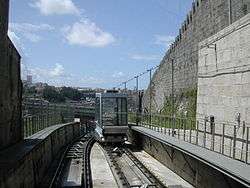Funicular dos Guindais
| Guindais Funicular (Funicular dos Guindais) | |
| Funicular (Funicular/Ascensor/Elevador) | |
 | |
| Official name: Ascensor dos Guindais | |
| Named for: Guindais | |
| Country | |
|---|---|
| Region | Norte |
| Subregion | Greater Porto |
| District | Porto |
| Municipality | Porto |
| Location | Cedofeita, Santo Ildefonso, Sé, Miragaia, São Nicolau e Vitória |
| - coordinates | 41°8′27.6″N 8°36′34.2″W / 41.141000°N 8.609500°WCoordinates: 41°8′27.6″N 8°36′34.2″W / 41.141000°N 8.609500°W |
| Architects | Raul Mesnier du Ponsard, Adélio Couto |
| Materials | Granite, Wood, Iron, Galvanized Steel |
| Origin | 19th century |
| - Initiated | 1891 |
| - Completion | 1893 |
| Owner | Portuguese Republic |
| For public | Public |
| Easiest access | Sé, Rua de Arnaldo Gama, Escadas dos Guindais |
| Management | Instituto Gestão do Patrimonio Arquitectónico e Arqueológico |
| Status | Unclassified |
| Listing | Included in the Historic Zone of the City of Porto (PT011312070086) |
| Length | 281 metres (922 ft) |
| Type | Single track with passing loop |
| Route diagram | |
| Wikimedia Commons: Funicular dos Guindais | |
| Website: http://www.metrodoporto.pt | |
The Guindais Funicular (Portuguese: Funicular dos Guindais) is a funicular railway in the civil parish of Cedofeita, Santo Ildefonso, Sé, Miragaia, São Nicolau e Vitória, Portuguese municipality of Porto.
History

The original line was inaugurated on 3 June 1891.[1] Almost 2 years later, on 5 June 1891, there was an accident caused by excess velocity, and the funicular car was decommissioned.[1]
The former "House" of the funicular railway was by 1993 occupied by an atelier operated by sculptor Henrique Moreira.[1] It was later remodelled to function as a meeting hall for local Jehovah's Witnesses.[1]
As part of a larger initiative to improve the transport infrastructure of Porto, a new funicular and station was inaugurated on 19 February 2004, following the same line as before.
Architecture
The funicular is situated along the wall of Freiras, running down a steep cliff between the quay at Guindais and Rua da Batalha (terminating at building of the Civil Governor).[2][3]
Owned and operated by the Porto Metro, the single-track funicular uses a central loop system that is 281 metres (922 ft) long, allowing it to descend 61 metres (200 ft), with the upper 90 metres (300 ft) situated within the passenger tunnel, with the markedly steep gradient in the section below the passing loop. Two vehicles run the course, with a capacity for 25 persons each, operating at a maximum speed of 5 metres per second (16 ft/s). Due to the difference in slope along the line, the cars have self-levelling platforms, allowing the car floor to maintain itself horizontal no matter the track incline.[2] Although the journey is short (approximately 3 minutes) after emerging from the upper tunnel, passengers are able to view the landscape from the Dom Luís I Bridge, the river margins (including both quays along Ribeira and Cais de Gaia and the Port wine warehouses and traditional boats along the Douro River.
The service is commonly used by locals/commuters to access the river and metro services, including the metro at São Bento: the service runs from 8:00 a.m. to 8:00 p.m. on weekdays, with extended hours to midnight on weekends and holidays.
Gallery
 Car at the passing loop
Car at the passing loop_(23958192671).jpg) Two the funicular cars as they each reach the passing loop
Two the funicular cars as they each reach the passing loop.jpg) The lower station
The lower station.jpg) The upper station
The upper station
See also
External links
References
Notes
- 1 2 3 4 Costa, Patrícia (2003), SIPA, ed., Casa do Ascensor dos Guindais (IPA.00020010/PT011312140272) (in Portuguese), Lisbon, Portugal: SIPA – Sistema de Informação para o Património Arquitectónico, retrieved 4 August 2016
- 1 2 "Funicular dos Guindais". POMA. Archived from the original on 2012-08-13. Retrieved 2012-08-13.
- ↑ Abreu, Andreia. "Andar de elevador é caro!" [Lift is expensive!] (in Portuguese). Jornalismo Porto Net. Archived from the original on 2012-08-13. Retrieved 2012-08-13.
Sources
- Porto a Património Mundial, Processo de Candidatura da Cidade do Porto à classificação pela UNESCO como Património Cultural da Humanidade - 1993 (in Portuguese), Porto, Portugal: Câmara Municipal do Porto, 1993